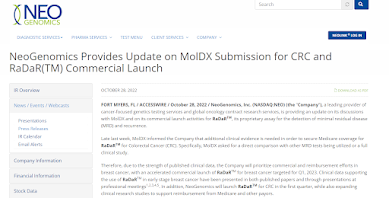On October 28, Neogenomics, a publicly held lab, issued a press release on the status of its efforts to get "MRD" (minimal residual disease) approval from MolDx. Find the press release here:
https://ir.neogenomics.com/press-releases/detail/224
"MolDX informed the Company that additional clinical evidence is needed in order to secure Medicare coverage for RaDaRTM for Colorectal Cancer (CRC). Specifically, MolDX asked for a direct comparison with other MRD tests being utilized or a full clinical study."
My understanding is that Neogenomics' MRD assets come from its Inivata acquisition; the Neogenomics website links through to the Inivata one. The press release also remarks that Neogenomics would pivot from CRC MRD to breast cancer MRD. (See a follow up article in 12/2022 on Neogenomics' progress with breast cancer MRD.)
On October 28, Neogenomics stock was down a little (6%) or about $60M on a market cap of $1B. Natera was up 2% or about $90M on its market cap of $4.6B.
What the LCD Says
Find LCD L38779 here (see also, however, billing article attachments to the LCD, AND tech assessment spreadsheets, the latter on the MolDx website). When the LCD was released, almost exactly a year ago, I referred to its publication as "a dramatic day for precision oncology" (here).
The LCD provides the potential for coverage of MRD tests for many different conditions, from different labs, within a four-box framework. The two axes are "solid organ cancers" vs hematopoietic ones, and "MRD for relapse/recurrence" vs "MRD for treatment response determination." However, any particular test, lab, and coverage indication is designed to be enumerated, one by one, on a rolling basis.
I think the Neogenomics press release is consistent with my reading of the LCD (and my hearing multiple talks by MolDx authors). MRD tests are all different, with their own approaches to exome testing (or the creation of tumor-naive tests as well), and circulating tumor DNA (ctDNA) may vary between types of cancers. Therefore, MolDx takes the position it's not enough to just (for example) say that your test is negative in these 20 cancer-free patients, and positive in these 20 with known metastatic cancer. Rather, you have to show the test actually picks up cancers at the new MRD stage, and accurately, in patients with that cancer type and earlier than imaging (or another standard of care.) (See my footnote on clinical trials. FN1).
Per the press release, MolDx is also communicating a bridging may be acceptable; for example, the covered Natera CRC MRD test is positive in these 25 patients and negative in these 25 patients and your test reports the same thing in each patient.
Summary
MolDx has approved only a relative handful of tests and cancers: The Natera MRD test for recurrent CRC or bladder cancer; the Natera treatment response test for checkpoint inhibitor therapy assessment; the Guardant test for CRC recurrence. The barrier to entry for getting a new lab, a new test, into the LCD MRD system, remains pretty high.
___
FN1
I don't have any special knowledge on the scale or design of a trial acceptable to MolDx. However, here's how I think about it. Consider screening tests for colorectal cancer at FDA. Typically, you need circa 100 positive colonoscopy patients to get tight statistics on your new test. But at a 1% positivity rate, you need to screen about 10,000 negative colonoscopy patients to sift out those position 100 ones. So CRC prevention tests for FDA tend to enroll about 10,000 patients.
Turn to MRD. Let's say hypothetically that colorectal patients have a 10% relapse rate at one year. Let's say you need at least 20 to have statistics on MRD performance (all 20 relapsed on imaging at time T(image), and each will have a detection of relapse with ctDNA at time T(mrd).) You need data that, for example, your test picked up relapse before imaging 17 times, the same as imaging 2 times, and the mrd test didn't ever turn positive 1 time (N=20). That's just a for-example. To get those 20 relapses patients, you'd need 200 enrollees, each followed for a year, so the trial duration is from the first enrollment day to the last enrollment day plus 1 year. Again, this isn't any promise of what MolDx wants to see, but just gives the reader a beginning way to begin to think about enrollment in an MRD test trial.
Endnote: Volatility in the MRD market
On October 28, Neogenomics stock was down a little (6%) or about $60M on a market cap of $1B. Natera was up 2% or about $90M on its market cap of $4.6B. (Guardant was unchanged.)
Remarkable are the 1-year share price ranges in this industry. Natera's one-year price range is $27-121 (current, $48). Neogenomics' is $6-47 (current $7.50).
